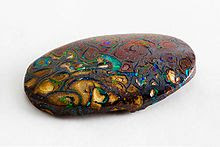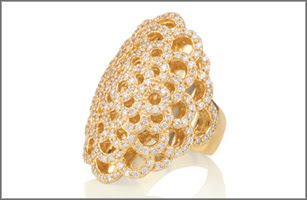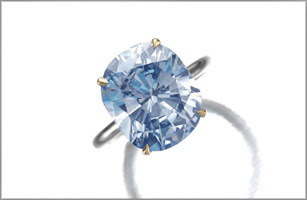source : wikipedia.org
Opal is a mineraloid gel which is deposited at a relatively low temperature and may occur in the fissures of almost any kind of rock, being most commonly found with limonite, sandstone, rhyolite, marl and basalt. The word opal comes from the Latin opalus, by Greek ὀπάλλιος opallios.
The water content is usually between three and ten percent, but can be as high as twenty percent. Opal ranges from clear through white, gray, red, orange, yellow, green, blue, magenta, rose, pink, slate, olive, brown, and black. Of these hues, the reds against black are the most rare, whereas white and greens are the most common. These color variations are a function of growth size into the red and infrared wavelengths. Opal is Australia's national gemstone.
Precious opal
Precious opal shows a variable interplay of internal colors and even though it is a mineraloid, it does have an internal structure. At micro scales precious opal is composed of silica spheres some 150 to 300 nm in diameter in a hexagonal or cubic close-packed lattice. These ordered silica spheres produce the internal colors by causing the interference and diffraction of light passing through the microstructure of the opal.It is the regularity of the sizes and the packing of these spheres that determines the quality of precious opal. Where the distance between the regularly packed planes of spheres is approximately half the wavelength of a component of visible light, the light of that wavelength may be subject to diffraction from the grating created by the stacked planes. The spacing between the planes and the orientation of planes with respect to the incident light determines the colors observed. The process can be described by Bragg's Law of diffraction.
Visible light of diffracted wavelengths cannot pass through large thicknesses of the opal. This is the basis of the optical band gap in a photonic crystal, of which opal is the best known natural example. In addition, microfractures may be filled with secondary silica and form thin lamellae inside the opal during solidification. The term opalescence is commonly and erroneously used to describe this unique and beautiful phenomenon, which is correctly termed play of color. Contrarily, opalescence is correctly applied to the milky, turbid appearance of common or potch opal. Potch does not show a play of color.
The veins of opal displaying the play of color are often quite thin, and this has given rise to unusual methods of preparing the stone as a gem. An opal doublet is a thin layer of opal, backed by a swart mineral such as ironstone, basalt, or obsidian. The darker backing emphasizes the play of color, and results in a more attractive display than a lighter potch.
Combined with modern techniques of polishing, doublet opal produces similar effect of black or boulder opals at a mere fraction of the price. Doublet opal also has the added benefit of having genuine opal as the top visible and touchable layer, unlike triplet opals.
The triplet-cut opal backs the colored material with a dark backing, and then has a domed cap of clear quartz or plastic on top, which takes a high polish and acts as a protective layer for the relatively fragile opal. The top layer also acts as a magnifier, to emphasize the play of color of the opal beneath, which is often of lower quality. Triplet opals therefore have a more artificial appearance, and are not classed as precious opal.
Precious opal consists of spheres of silica of fairly regular size, packed into close-packed planes which are stacked together with characteristic dimensions of several hundred nm.Common opal
Besides the gemstone varieties that show a play of color, there are other kinds of common opal such as the milk opal, milky bluish to greenish (which can sometimes be of gemstone quality), resin opal which is honey-yellow with a resinous luster, wood opal which is caused by the replacement of the organic material in wood with opal, menilite which is brown or grey, hyalite is a colorless glass-clear opal sometimes called Muller's Glass, geyserite, also called siliceous sinter, deposited around hot springs or geysers and diatomite or diatomaceous earth, the accumulations of diatom shells or tests.
Other varieties of opal

Fire opals are transparent to translucent opals with warm body colors yellow, orange, orange-yellow or red and they do not usually show any play-of-color, although occasionally a stone will exhibit bright green flashes. The most famous source of fire opals is the state of Querétaro in Mexico and these opals are commonly called Mexican fire opals.
Peruvian opal (also called blue opal) is a semi-opaque to opaque blue-green stone found in Peru which is often cut to include the matrix in the more opaque stones. It does not display pleochroism.
Sources of opal
Australia produces around 97% of the world's opal. 90% is called ‘light opal’ or white and crystal opal. White makes up 60% of the opal productions but cannot be found in all of the opal fields. Crystal opal or pure hydrated silica makes up 30% of the opal produced, 8% is black and only 2% is boulder opal.
The town of Coober Pedy in South Australia is a major source of opal. Andamooka in South Australia is also a major producer of matrix opal, crystal opal, and black opal. Another Australian town, Lightning Ridge in New South Wales, is the main source of black opal, opal containing a predominantly dark background (dark-gray to blue-black displaying the play of color). Boulder opal consists of concretions and fracture fillings in a dark siliceous ironstone matrix. It is found sporadically in western Queensland, from Kynuna in the north, to Yowah and Koroit in the south.
The Virgin Valley opal fields of Humboldt County in northern Nevada produce a wide variety of precious black, crystal, white, fire, and lemon opal. The black fire opal is the official gemstone of Nevada. Most of the precious opal is partial wood replacement. Miocene age opalised teeth, bones, fish, and a snake head have been found. Some of the opal has high water content and may desiccate and crack when dried. The largest black opal in the Smithsonian Institution comes from the Royal Peacock opal mine in the Virgin Valley.
Another source of white base opal or creamy opal in the United States is Spencer, Idaho. Spencer has an open pit mine that you can visit for a fee, about 4 times a year. One business in Spencer also brings material down from the mine site to their store, so that would be opal miners can dig for their own opal, again for a nominal fee. A high percentage of the opal found there occurs in thin layers. As a result, most of the production goes into the making of doublets and triplets.
Other significant deposits of precious opal around the world can be found in the Czech Republic, Slovakia, Hungary, Turkey, Indonesia, Brazil (Pedro II a city in the state of Piauí), Honduras, Guatemala, Nicaragua and Ethiopia.
In late 2008, NASA announced that it had discovered opal deposits on Mars.
Historical superstitions
In the Middle Ages, opal was considered a stone that could provide great luck because it was believed to possess all the virtues of each gemstone whose color was represented in the color spectrum of the opal. It was also said to confer the power of invisibility if wrapped in a fresh bay leaf and held in the hand.Following the publication of Sir Walter Scott's Anne of Geierstein in 1829, however, opal acquired a less auspicious reputation. In Scott's novel, the Baroness of Arnheim wears an opal talisman with supernatural powers. When a drop of holy water falls on the talisman, the opal turns into a colorless stone and the Baroness dies soon thereafter. Due to the popularity of Scott's novel, people began to associate opals with bad luck and death.Even as recently as the beginning of the 20th century, it was believed that when a Russian saw an opal among other goods offered for sale, he or she should not buy anything more since the opal was believed to embody the evil eye.
Opal is considered the birthstone for people born in October or under the sign of Libra and the star stone for people born under Scorpio.


















































